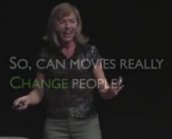Archive for Media Impact Project
March 17, 2015 at 11:40 am · Filed under advertising, jb exploits, media impact, online culture, social media and tagged: London, Media Impact Project, metrics, mobile, news, ONA, snapchat

The degree of personalization and algorithmic curation used in the delivery of mobile news was a key theme at ONA Mobile, which brought together an international array of digital-savvy journalists in the organization’s first convening outside the U.S. The Lear Center’s Media Impact Project sponsored the conference, in part, because we see mobile fast-becoming the primary platform for news delivery. And, although mobile is still very much in a Wild West phase, where accepted standards are few and far between, the opportunities to measure real impact on people’s lives is simply unprecedented.
As many speakers acknowledged, mobile is “very hard” but the pay-offs are definitely worth the pain. Between the rigors of submitting to Apple, maintaining mobile-responsive websites, reformatting for Snapchat, and navigating the ever-changing rules at Facebook, mobile news providers are constantly challenged to make it pithier and make it relevant. In many ways, I’d argue that mobile pushes journalists to achieve a new level of rigor in reporting. Read the rest of this entry »
July 11, 2014 at 11:19 am · Filed under film, jb exploits, media impact, TV and tagged: CDC, Contagion, entertainment education, food, Hollywood Health & Society, Inc., Media Impact Project, New York Times, Participant Media, survey research, The Norman Lear Center, The Participant Index, Waiting for Superman

The New York Times devoted significant ink this week to The Participant Index (TPI), an effort by Participant Media to quantify and compare the relative social impact of films, TV shows and online video. The article also mentioned the Lear Center’s $4.2 million Media Impact Project: I’m the co-principal investigator on that project and we’ve been consulting with Participant on the development of TPI.
Here’s a little back story: Participant approached the Lear Center because of its academic expertise in measuring the impact of educational messages embedded in entertainment content. Our Hollywood, Health & Society program (for which I wrote the initial grant) has partnered with the CDC for the last 14 years to look at how health story lines in popular TV shows affect viewers’ knowledge, attitudes and behavior. The survey component of TPI includes a combination of questions that have become standard in entertainment education evaluation: the “transportation scale” identifies the type of emotional involvement that the entertainment content triggered and the outcome questions indicate what real-world actions a subject has taken after exposure to the content. TPI combines these two measures to create a score for each piece of video content in the study. Read the rest of this entry »
April 17, 2014 at 10:43 am · Filed under media impact, online culture, social media, TV and tagged: Black Twitter, Kerry Washington, Media Impact Project, Scandal, Shonda Rhimes, social-media, TV, Twitter

A few years ago I noticed a bunch of hashtags appearing in the “Trending Topics” section of Twitter that I just couldn’t make heads or tails of. Each one I clicked on revealed a sea of black faces and I thought, Oh! This is some kind of in-joke in the African American community. When I could figure out what the tweets were about (and often I couldn’t), they were often really funny, sometimes poking fun at black celebrities or taking white people to task for their ignorance of black culture and the black experience. There were also a lot of provocative topics such as #thingsblackpeopledo, which often played with sensitive racial stereotypes (think watermelon, unemployment, etc.) sometimes inverting them or re-invoking them in clever and surprising ways.
This development was really exciting to me because I believe that one of the huge social and political benefits of social media networks is that diasporic communities – dispersed groups that have shared interests – can cheaply and easily find one another, exchange ideas, build community and work together to accomplish shared goals.
Fast forward to 2013: we had just launched the new Media Impact Project at the Norman Lear Center and I was looking for a way to collaborate with the Annenberg Innovation Lab, a group at USC that had been publishing some very interesting research on Twitter. I was thrilled when Kevin Driscoll, a PhD student in the Lab, told me that he was hoping to drum up some interest in researching Black Twitter. We had both noticed that academic researchers hadn’t really grappled with the topic yet, even though the phrase was becoming more common in news media after Black Twitter was given credit for focusing media attention on the Trayvon Martin and Jordan Davis cases.
We were also a bit surprised that academics didn’t seem to be responding to studies demonstrating that African Americans were seriously embracing Twitter. A research team at Northwestern found that black college students were over-represented on Twitter and Pew found that an astounding 28% of African Americans use Twitter with 13% using it on a daily basis. Just to give you some context, only 12% of whites are on Twitter and only 2% of all online adults use Twitter in a typical day.
Whoa. Read the rest of this entry »
October 18, 2013 at 11:53 am · Filed under film, jb exploits, media impact and tagged: activism, Allison Cook, Beth Karlin, Creative Visions, documentary, film, JLove Calderon, Jon Fitzgerald, Media Impact Project, media research, Michael Crooke, SEA Change, social change
This summer, I spent a great day with a bunch of filmmakers at the Topanga Film Festival. Their goal? Making sure that their documentaries would have a real, measurable social impact.
Just making a smart, moving film about a pressing social issue isn’t necessarily going to change the world. It’s crucial for filmmakers to know what they can do to optimize the possibilities for impact.
It’s not just about good marketing. It turns out that there’s a treasure trove of compelling academic research that filmmakers can tap in order to increase the chances that their work will hit its mark.
Beth Karlin, the director of the Transformational Media Lab at UC Irvine, has become an expert on the interdisciplinary art of using storytelling to increase social engagement and trigger social change. Karlin has joined forces with Jon Fitzgerald, a filmmaker who co-founded Slamdance and the author of Filmmaking for Change, in order to create a workshop curriculum that informs filmmakers about how they can maximize their potential to effectively address pressing social issues.
My new Media Impact Project at the Lear Center shares those goals, and so I have joined Beth and Jon in an initiative that we’re calling SEA Change. Here’s what it’s about:
The SEA Change approach to designing and assessing film campaigns leverages Storytelling, Engagement and Activism for Change. It synthesizes academic theory, empirical research and the lived experience of storytellers and activists, with an eye towards exposing what we know, exploring what we don’t, and leveraging our connections to maximize impact. We focus on developing measurable goals and using theory and findings from the social sciences as well as from analysis of successful cases to meet and measure these goals.
The workshop at Topanga included Michael Crooke, a film funder who was the former CEO of Patagonia. and a wide range of filmmakers affiliated with the Creative Visions Foundation, which supports media activists and incubates artistic projects in a ridiculously awesome space on the beach in Malibu. Beth, Jon and I had a chance to test out our ideas about how to inform filmmakers about relevant research and structure a program that would allow them to actively learn from one another. It was an incredibly stimulating experience and one that we will reiterate on November 17, 2013, immediately following the Creative Activist Arts Festival. We’re putting together an 8-week workshop as well: for more information about that, or to join our mailing list, email seachangeinstitute at gmail dot com.
Join us for a panel discussion at the Hollywood Film Fest (where Jon just happens to be the Executive Director) on October 19 at 11am at the ArcLight Hollywood. Beth, Jon and I will be joined by award-winning author, producer, and director JLove Calderon, and the delightful Allison Cook, a creator of the wildly successful Story of Stuff Project.
April 30, 2013 at 10:07 am · Filed under advertising, film, jb exploits, media impact, online culture, theater, TV and tagged: audiences, demographics, film, Gates Foundation, Knight Foundation, media, Media Impact Project, norman lear center, TV

Yesterday, I was very excited to launch the Media Impact Project, which aspires to be a global hub for the best research on measuring the impact of media. Supported by $3.25 million in initial funding from the Gates and Knight Foundations, I’m optimistic that the Norman Lear Center can help make media more accountable to audiences and contribute to a better understanding of the role that media plays in people’s lives.
The New York Times picked up the story and I was thrilled to see reporter Michael Cieply focus on this aspect of the program:
Read the rest of this entry »



















